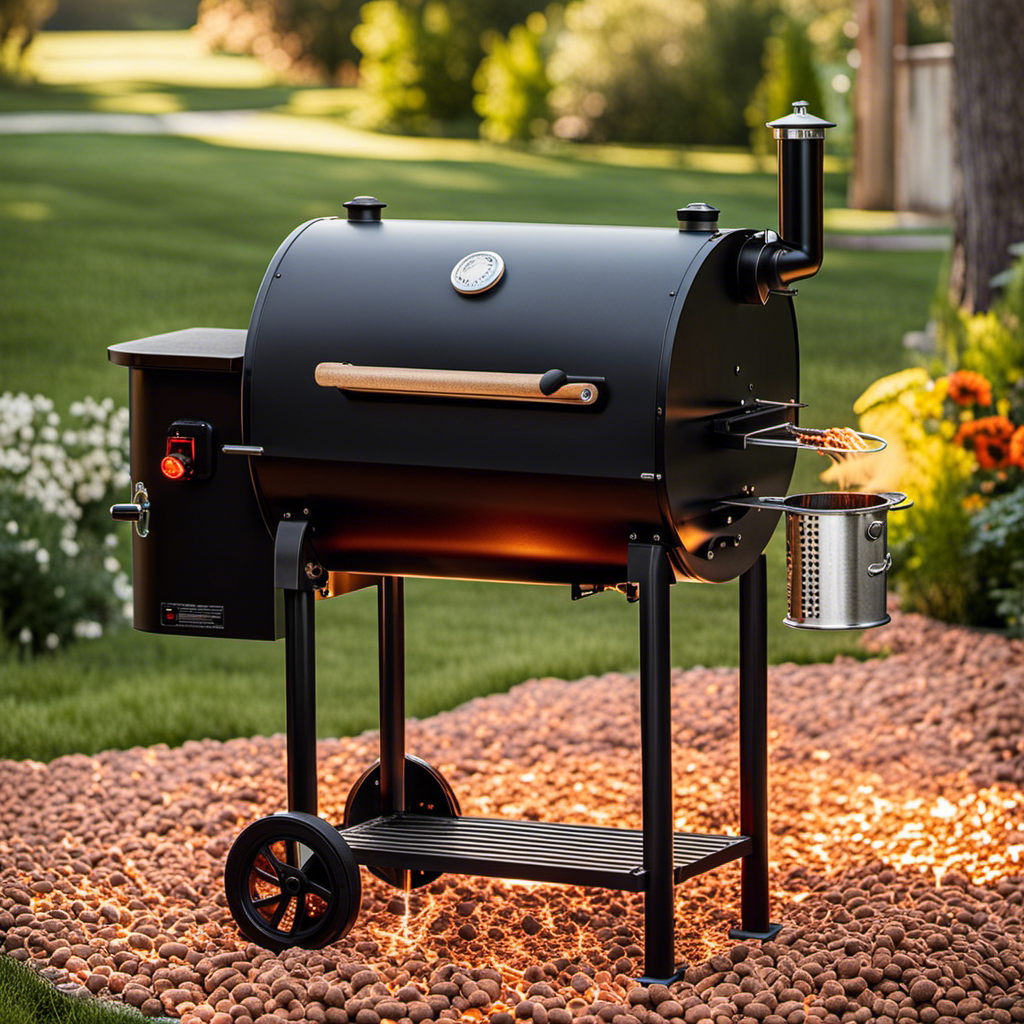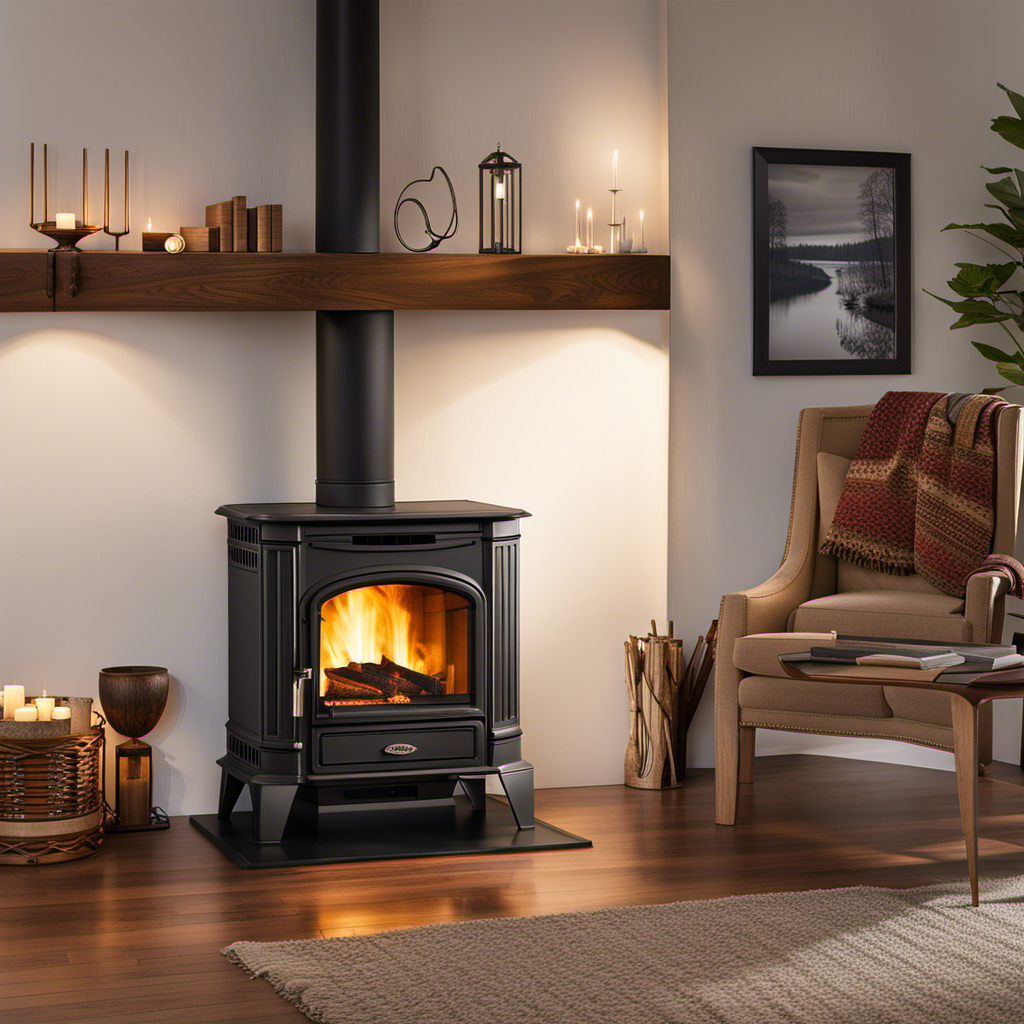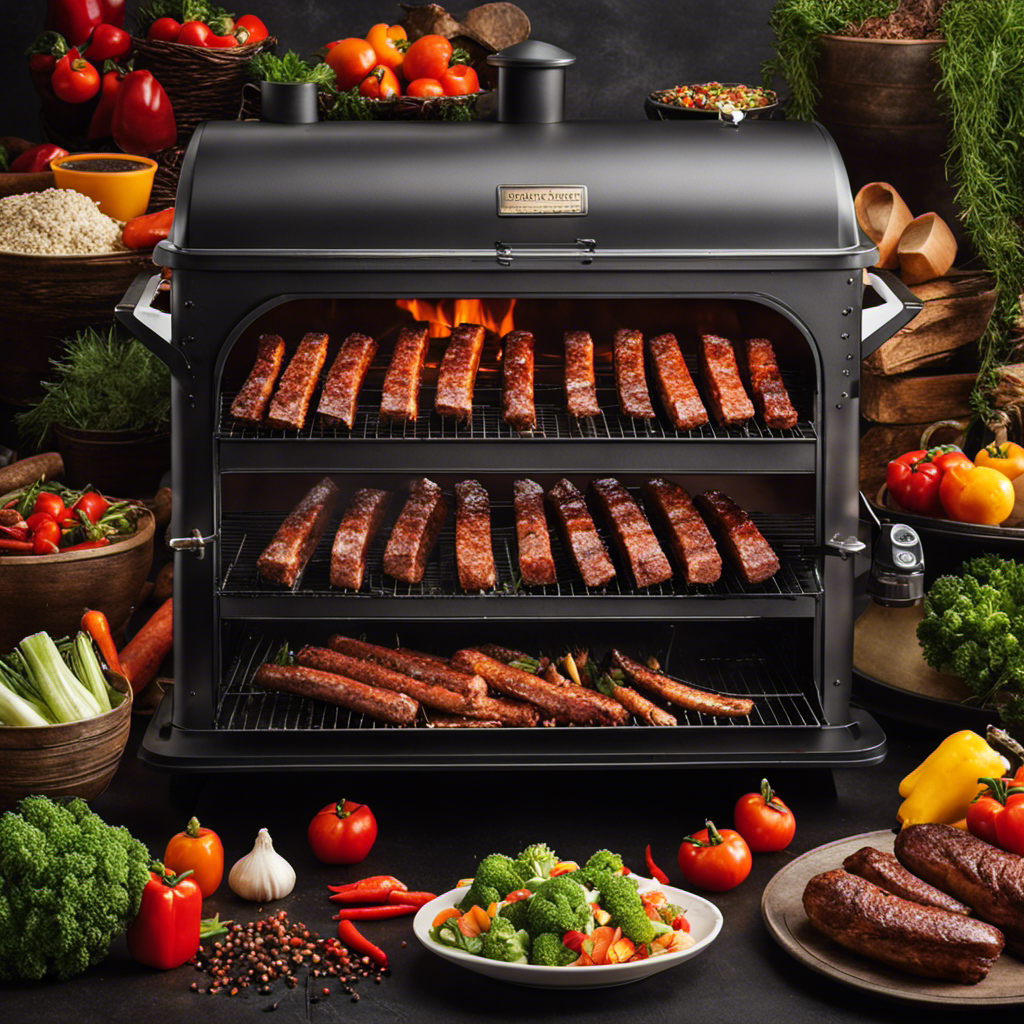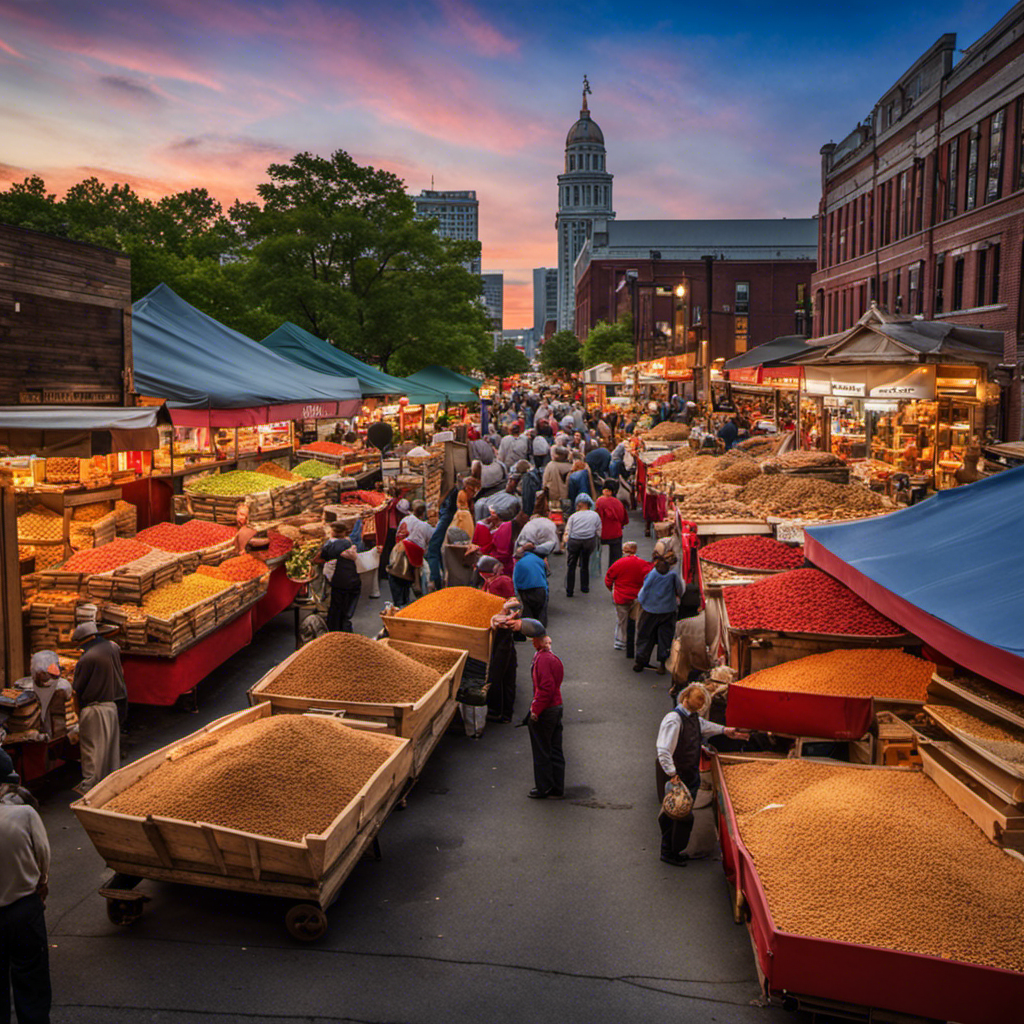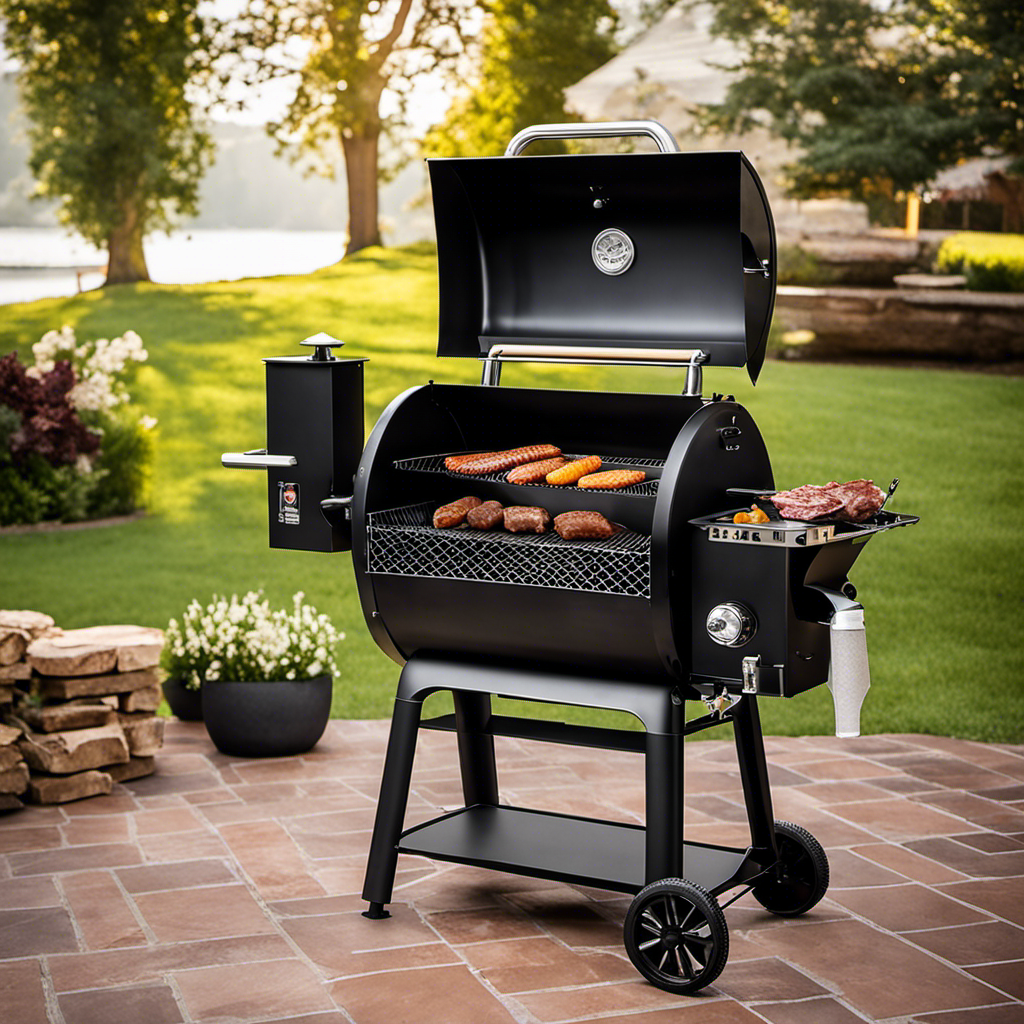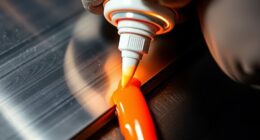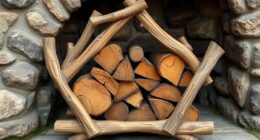Have you ever been curious about how a wood pellet grill manages to light those pellets and produce the ideal smoky taste? Trust me, it’s genuinely captivating!
In this article, we’ll explore the intricate workings of the ignition system and delve into the role of airflow in lighting those pellets.
We’ll also discuss common issues that can arise during the process and share some expert tips for efficiently lighting your pellets.
So sit back, relax, and prepare to be amazed by the inner workings of your trusty wood pellet grill.
Key Takeaways
- Wood pellet grills use electric igniters or fire starters to light the pellets.
- Proper airflow and oxygen supply are crucial for efficient pellet ignition.
- Factors affecting pellet ignition include the quality of fire starter material, airflow within the grill, and the dryness of pellets.
- Adjustable vents or dampers control the amount of oxygen entering the grill and help maintain a consistent temperature.
The Ignition System
The ignition system is responsible for lighting the wood pellets in a wood pellet grill. Most wood pellet grills utilize an electric igniter to ignite the pellets. When you turn on the grill, an electric current passes through a heating element, causing it to heat up and ignite the pellets.
Understanding ignition mechanisms and troubleshooting lighting issues can ensure a successful grilling experience. If you’re experiencing issues with lighting, check if the igniter is working properly by listening for a clicking sound or visually inspecting for any signs of damage or wear. Additionally, make sure there are no obstructions blocking the flow of air to the fire pot, as this can affect ignition.
Now let’s move on to understanding the heating element and its role in maintaining consistent temperatures during cooking.
Understanding the Heating Element
To understand how it works, you’ll first need to know about the heating element in a wood pellet grill. The heating element is responsible for igniting the pellets and creating the heat needed for cooking.
Here’s how it works:
-
The ignition mechanism: The pellet grill usually has an automatic ignition system that uses electricity to spark the fire. This mechanism ensures a quick and efficient start-up process.
-
Pellet ignition process: Once the ignition system is activated, it ignites a small amount of pellets located in the fire pot. As these pellets burn, they create a flame that gradually spreads to ignite more pellets.
-
Heat distribution: The heating element not only ignites the pellets but also distributes heat evenly throughout the grill. This ensures that your food cooks evenly, resulting in delicious meals every time.
Understanding how the heating element functions is crucial in comprehending the role of airflow in lighting pellets.
The Role of Airflow in Lighting Pellets
Understanding how airflow helps ignite the pellets is essential in comprehending the heating element’s function. Airflow management plays a crucial role in lighting wood pellets on a grill.
When the grill is turned on, an igniter technology is used to generate heat and start the combustion process. As the igniter heats up, it creates hot air that is then circulated throughout the grill by strategically placed fans or vents. This airflow not only ensures that oxygen reaches the burning pellets but also helps distribute heat evenly across the cooking surface.
By controlling the amount of air entering and exiting the combustion chamber, you can regulate the intensity of the fire and maintain a consistent temperature for cooking.
Transitioning into controlling the combustion process, let’s explore how adjusting these airflow controls allows for precise temperature control and enhances grilling performance.
Controlling the Combustion Process
When it comes to controlling the combustion process in a wood pellet grill, two key factors to consider are the oxygen supply and temperature regulation methods.
The availability of oxygen is crucial for the combustion of wood pellets, as it provides the necessary fuel for the fire. Various mechanisms can be employed to control the amount of oxygen entering the grill, such as adjustable vents or dampers.
Additionally, temperature regulation methods play a vital role in achieving optimal cooking conditions. These may include features like digital controllers that monitor and adjust the airflow and fuel input to maintain a consistent temperature throughout the cooking process.
Oxygen Supply for Combustion
The wood pellet grill requires a sufficient oxygen supply for proper combustion of the pellets. Without enough oxygen, the combustion process would be hindered and the pellets wouldn’t ignite efficiently.
Here are some key factors that contribute to maintaining the necessary oxygen supply:
-
Air vents: These allow fresh air to enter the grill, providing a continuous flow of oxygen.
-
Ignition sources: The grill is equipped with an electronic ignition system or a hot rod that ignites the pellets, initiating the combustion process.
-
Pellet hopper design: A well-designed hopper ensures proper ventilation, allowing air to circulate around the pellets.
-
Combustion chamber design: The chamber facilitates airflow, allowing oxygen to reach all parts of the burning pellets.
All these elements work together to ensure that there is enough oxygen available for combustion.
Once ignited, temperature regulation methods come into play to control the cooking process without needing complicated steps or procedures.
Temperature Regulation Methods
To regulate the temperature on your wood pellet grill, you can adjust the airflow using the control knobs. Temperature regulation is crucial for achieving perfect cooking results.
One technique for controlling the temperature is to adjust the air intake and exhaust vents. Opening these vents allows more oxygen into the firebox, increasing combustion and raising the temperature. Conversely, closing them restricts airflow and lowers the temperature.
Another method involves adjusting the feed rate of pellets into the fire pot. Increasing or decreasing this rate affects how quickly new fuel is added to maintain or decrease heat levels.
If you’re having trouble igniting your pellets, there are a few troubleshooting techniques you can try. First, ensure that there are no blockages in your pellet hopper or auger system that could hinder proper pellet flow. Additionally, check if there is enough fuel in the hopper and that it’s not damp or compromised in any way.
Proper ventilation plays a crucial role in maintaining consistent temperatures on your wood pellet grill.
The Importance of Proper Ventilation
When it comes to grilling, understanding the importance of proper ventilation is crucial.
Oxygen plays a vital role in combustion, fueling the fire and allowing for efficient heat generation.
By controlling the amount of oxygen that reaches the grill, we can effectively regulate the temperature and achieve optimal cooking conditions.
However, it’s essential to keep safety considerations in mind when dealing with open flames and hot surfaces, ensuring a safe and enjoyable grilling experience.
Oxygen for Combustion
Make sure you have enough oxygen flowing into your wood pellet grill for combustion to occur and light up the pellets. Ignition techniques and pellet combustion rely heavily on the presence of oxygen to create a fire and sustain it. Oxygen is crucial for the chemical reaction that takes place when pellets are ignited, producing heat and smoke for cooking.
To better understand the role of oxygen in pellet ignition, let’s take a look at this table:
| Ignition Techniques | Pellet Combustion |
|---|---|
| Hot Rod Igniter | Efficient |
| Electric Starter | Reliable |
| Fire Starters | Quick |
As you can see, different ignition techniques can be used depending on your preference or grill model. However, regardless of the method chosen, proper airflow is essential to ensure efficient combustion.
Now that we know how important oxygen is for lighting up the pellets, let’s explore temperature control techniques to maintain a steady heat without using ‘step’.
Temperature Control Techniques
Now that we understand how oxygen is crucial for combustion in a wood pellet grill, let’s explore some temperature control techniques and safety measures for pellet ignition. These techniques are essential for achieving the desired cooking temperature and ensuring a safe grilling experience.
-
Airflow adjustment: Controlling the airflow into the firebox allows you to regulate the intensity of the fire. Increasing airflow will raise the temperature, while reducing it will lower the heat output.
-
Fuel adjustment: Adjusting the amount of wood pellets added to the hopper can also impact temperature control. Adding more pellets will increase heat production, while reducing them will result in lower temperatures.
-
Ignition safety: Prior to igniting your grill, ensure that there are no flammable materials nearby and that all necessary safety precautions have been taken. It’s important to follow manufacturer guidelines and recommendations when starting your grill.
Transitioning into our next section on ‘safety considerations when grilling’, let’s delve deeper into how we can ensure a safe grilling experience without compromising on delicious results.
Safety Considerations When Grilling
Transitioning into our next section on safety considerations when grilling, let’s explore how we can ensure a safe and enjoyable grilling experience.
When it comes to grilling, taking proper precautions is essential to prevent accidents and ensure the safety of everyone involved. First and foremost, always keep a fire extinguisher nearby in case of emergencies. It’s also important to clean your grill regularly to remove grease buildup that could potentially cause flare-ups. Additionally, never leave your grill unattended while it’s in use and make sure it is placed on a stable surface away from any flammable materials. Finally, always follow the manufacturer’s instructions for lighting and extinguishing your grill properly.
By following these grilling precautions and practicing fire prevention methods, you can enjoy the deliciousness of grilled food without any worries about safety hazards or accidents.
Now let’s transition into exploring different ignition methods for wood pellet grills.
Exploring Different Ignition Methods
There are various ways to ignite the wood pellets in a grill. Two common methods include using an electric ignition or a hot rod.
Electric ignitions are commonly found in pellet grills and provide a convenient and reliable method of starting the fire. This type of ignition uses a heating element that heats up when you turn on the grill. It ignites the pellets and creates the necessary flame for cooking.
On the other hand, hot rods are another popular option for lighting wood pellets. These rods are made from durable materials like ceramic or stainless steel. They can reach temperatures high enough to ignite the pellets within minutes.
When it comes to best practices, it’s essential to follow your grill manufacturer’s instructions for proper usage of these different types of ignitions.
Transitioning into factors affecting pellet ignition, understanding how these ignition methods work is crucial in troubleshooting any issues that may arise during startup.
Factors Affecting Pellet Ignition
To ensure successful ignition, you should consider factors such as the quality of your fire starter material and the airflow within the grill. Ignition techniques play a crucial role in lighting pellets efficiently. Here are three key factors that can affect pellet ignition:
-
Quality of Fire Starter Material: Using high-quality fire starters, such as paraffin cubes or hardwood pellets, ensures a reliable ignition source. These materials provide consistent heat and burn evenly, making it easier to light the pellets.
-
Airflow within the Grill: Proper airflow is essential for combustion and igniting the pellets effectively. Ensure that the air vents on your grill are open to allow sufficient oxygen flow. This will create a strong flame and promote even burning throughout the pellet bed.
-
Dryness of Pellets: Moisture content in wood pellets can impact their ignition ability. It’s important to store your pellets in a dry place to avoid any moisture absorption. Dryer pellets ignite more easily and produce more consistent heat during cooking.
Common Issues With Lighting Pellets
When it comes to lighting wood pellets in a grill, there can be some common issues that arise. Pellet ignition problems can occur due to factors such as moisture content, airflow restrictions, or improper positioning of the igniter.
Proper pellet lighting is crucial for a successful and efficient grilling experience, so troubleshooting these issues is essential to ensure consistent heat and flavor.
Pellet Ignition Problems
If you’re having trouble lighting the wood pellets in your grill, try adjusting the airflow to ensure proper ignition.
When it comes to pellet lighting techniques, troubleshooting ignition problems can be frustrating. One common issue is inadequate airflow, which can prevent the pellets from igniting and producing a steady flame.
To troubleshoot this problem, start by checking if the air vents are fully open or partially blocked. Adjusting them accordingly can enhance oxygen flow and promote better combustion.
Additionally, make sure that the fire pot is clean and free from any debris or ash buildup that may obstruct airflow.
By addressing these issues with pellet ignition, you’ll be on your way to achieving proper pellet lighting and getting that perfect sear on your food without a hitch.
Now let’s move on to exploring the key elements of proper pellet lighting…
Proper Pellet Lighting
Achieving a proper pellet lighting technique can greatly enhance the flavor and sear of your food. When it comes to igniting wood pellets in a grill, timing is everything. It’s important to allow enough time for the pellets to catch fire and produce a steady flame before you start cooking. This ensures that the grill reaches the optimal temperature for searing and adds that delicious smoky flavor to your food. Ignition timing also plays a role in fuel efficiency. If the pellets are not lit properly, they may burn inefficiently, wasting fuel and causing fluctuations in temperature. To improve ignition timing, make sure to follow the manufacturer’s instructions and give the pellets enough time to ignite fully before adding your food.
Transitioning into troubleshooting pellet lighting, there are times when even with proper techniques, issues can arise…
Troubleshooting Pellet Lighting
To troubleshoot lighting issues, you can try adjusting the airflow to ensure a steady flame. Proper pellet lighting is crucial for efficient grilling and smoking on a wood pellet grill.
However, sometimes you may encounter difficulties in getting your pellets to light up properly. One common issue is when the pellets fail to ignite or burn inconsistently. This could be due to insufficient airflow around the fire pot.
To troubleshoot this, check if the air intake vents are open and unobstructed. Adjusting these vents can increase or decrease the amount of oxygen reaching the fire pot, which will help regulate the flame intensity. Another possible solution is to clean any ash buildup in the fire pot and make sure there are no blockages in the pellet delivery system.
By addressing these troubleshooting steps, you can ensure that your wood pellet grill lights up efficiently.
Now let’s move on to some tips for efficiently lighting pellets without any further delay…
Tips for Efficiently Lighting Pellets
One effective way to efficiently light wood pellets in a grill is by using a chimney starter. Here are some tips I’ve learned while exploring alternative methods and troubleshooting techniques:
- Use newspaper or fire starters to ignite the pellets quickly and evenly.
- Arrange the pellets in a pyramid shape inside the chimney starter for optimal airflow.
- Place the lit newspaper or fire starter underneath the chimney starter and let it burn until the pellets catch fire.
- Once the pellets are glowing red, carefully transfer them to the grill’s pellet chamber.
By following these steps, you can ensure that your wood pellets ignite efficiently and provide consistent heat for grilling.
Now, let’s move on to discussing safety measures for pellet ignition without compromising on flavor or quality.
Safety Measures for Pellet Ignition
Make sure you follow these safety measures when igniting your wood pellets in order to prevent accidents and ensure a safe grilling experience. Igniting wood pellets can be a straightforward process, but it is important to take the necessary precautions to avoid any mishaps.
First and foremost, always read the manufacturer’s instructions before attempting to light the pellets. Make sure you are using a designated pellet grill or smoker that is designed for this purpose.
Before igniting the pellets, ensure that there is no flammable material nearby and that the grill is placed on a stable surface. Use long-handled matches or a propane torch specifically made for lighting pellets. Apply the flame directly to the pellets while ensuring proper air circulation within the grill.
Always supervise the ignition process until you are confident that it has started properly. By following these proper techniques and taking necessary safety precautions, you can enjoy a safe and enjoyable grilling experience with wood pellet fuel.
Frequently Asked Questions
How Long Does It Take for a Wood Pellet Grill to Light the Pellets?
It usually takes about 10-15 minutes for a wood pellet grill to light the pellets. To troubleshoot a grill that won’t light, check the power source, igniter, and air flow. For quick and efficient ignition, ensure proper pellet placement and clean the grill regularly.
Can I Use Any Type of Pellets in a Wood Pellet Grill?
Using different types of pellets in a wood pellet grill can enhance the flavors of your food. However, it’s important to ensure the availability and compatibility of these pellets with your specific grill model.
Is There a Specific Temperature at Which the Pellets Should Be Lit?
There is a specific temperature at which the pellets should be lit in order to ensure proper combustion and flavor. It’s important to follow proper pellet lighting techniques for optimal results.
What Are Some Common Mistakes People Make When Lighting Pellets in a Wood Pellet Grill?
When lighting pellets in a wood pellet grill, common mistakes include using damp or low-quality pellets, not properly cleaning the grill before ignition, and not allowing enough time for the pellets to ignite fully. Here are some tips for achieving the perfect pellet ignition.
Are There Any Specific Safety Precautions I Should Take When Lighting the Pellets in a Wood Pellet Grill?
When lighting pellets in a wood pellet grill, it is important to take specific safety precautions. Following best practices ensures a safe experience.
Conclusion
In conclusion, lighting wood pellets in a grill involves understanding the ignition system and heating element, as well as controlling airflow and ensuring proper ventilation. Factors such as pellet quality and moisture content can affect ignition success. Common issues include improper placement of pellets or incorrect temperature settings.
To efficiently light pellets, preheat the grill and use a high-quality igniter. Safety measures include wearing protective gear and keeping flammable objects away from the grill.
So next time you fire up your wood pellet grill, ask yourself: Can you envision the sizzle of perfectly lit pellets transforming into mouthwatering grilled goodness?

